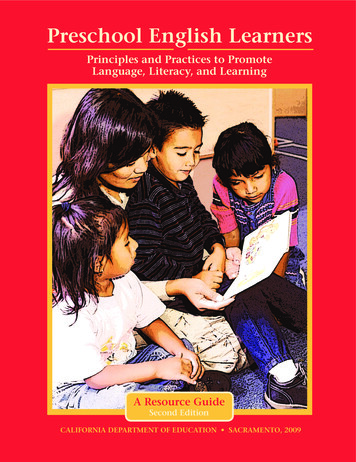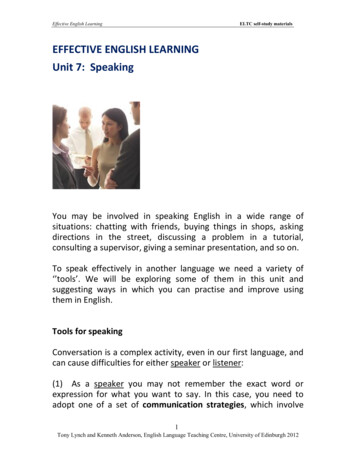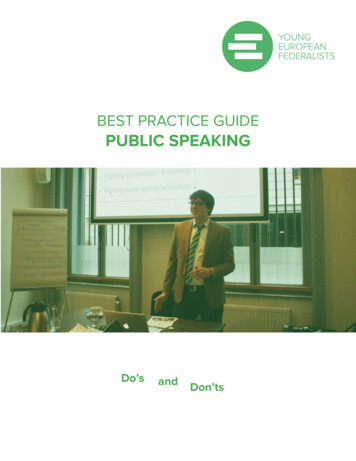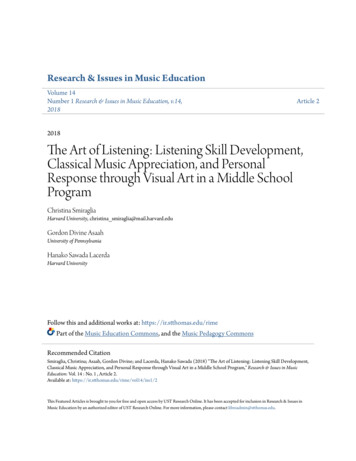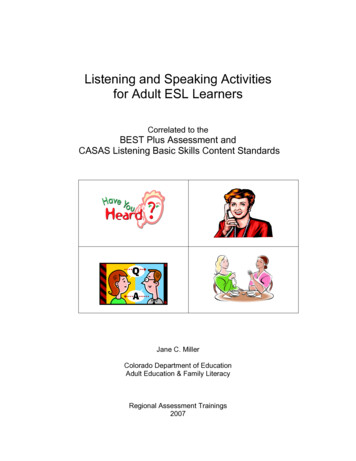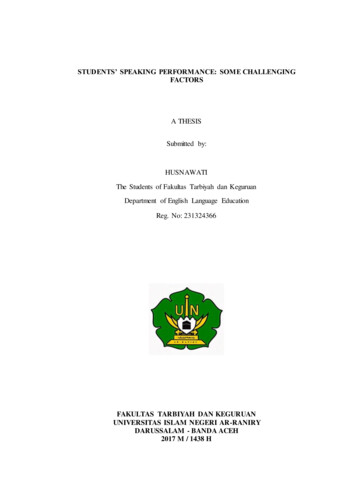
Transcription
Teaching English with Technology, 19(2), 101-108, http://www.tewtjournal.orgLEARNING ENGLISH LISTENING AND SPEAKINGTHROUGH BBC VOA PODCASTS:AN APP REVIEWby Samaneh Abdi and Hossein MakiabadiFerdowsi University of Mashhad, Azadi Square, Mashhad, Iranabdi.samaneh @ mail.um.ac.ir; hossein.makiabadi @ mail.um.ac.irAbstractKnowing another language other than the first language is stereotypically regarded as aprestigious feature, distinguishing an individual from the rest of the community whileproviding him/her with more job opportunities. Nowadays, language classes are easilyavailable through the expansion of recent technologies such as MALL (Mobile-AssistedLanguage Learning) and language learning applications (apps). App developers have beencompeting to design the most efficient apps to facilitate meaningful language learning byfocusing on oral production and auditory reception to increase language learners'communicative competence. A characteristic app of the kind is Learning English Listening &Speaking BBC/ VOA News which offers learners a massive archive of updated BBC and VOApodcasts both online and offline. The current review intends to present a detailed description ofthe important features of this app.Keywords: mobile-assisted language leaning, learn English listening & speaking BBC/ VOAnews, listening, speakingApplication Details:Publisher: Learning English BBC, VOA NewsProduct type: Smartphone Application SoftwareLanguage(s): EnglishLevel: AdvancedMedia format: APKOperating systems: AndroidHardware requirements: Smartphone/Internet ConnectionSupplementary software: A Virtual Private Network (VPN) in some regionsPrice: Free101
Teaching English with Technology, 19(2), 101-108, http://www.tewtjournal.org1021. IntroductionWith an exponential and progressive increase in the usage of iPhone and Android operatingsystems, the range of activities using mobile phones has expanded from downloading musictracks and images to downloading and running hundreds of applications (apps) designed for avariety of purposes, including educational goals (Godwin-Jones, 2011). Therefore,technologically-prompted educators have attempted to improve teaching and learningconditions through developing and utilizing educational apps (Shen, Wag & Pan, 2008). Theevidence for the effectiveness of mobile-assisted language learning (MALL) apps inconsolidating the teaching and learning of a second or foreign language has been suggested in alarge number of studies (see Burston, 2013 for a review).Mastering a second language (L2), especially English, is of great significance to survivetoday’s educational and economic challenges through majoring in the century’s top disciplinesand finding a well-paid job. Many apps (e.g., Dulingo, Memrise, Magoosh, Mosalingua, etc.)have been developed in the field of English language learning with their focus on oral,receptive, or all the basic language skills. It has been a while that podcasting, with a focus onlistening and speaking skills, have gained the interest of many learners and educators (Hasan &Hoon, 2013; Yeh, 2017) since both of these skills have been considered as learners’ tools incommunication (Brown, 1994). Research has shown that listening is the most important skilland should be prioritized over other skills as it plays a pivotal role in the improvement of otherlanguage skills (Masalimova, Porchesku, & Liakhnovitch, 2016; Rost, 2002; Vandergrift,2007). Hence, it is vitally essential for learners to develop their L2 listening competence.However, despite its significance, L2 learners are not well-taught on this skill and its requisitestrategies such as contextualizing (LeLoup & Pontiero, 2007; Mendelsohn, 2006). As aninstance, the results of a study by Kim (2013) demonstrated that contextualizing MALLadvances listening skills.Owing to the variety of accessible apps, it might probably be difficult to select only oneapp as a learning tool, especially one that is really efficient for improving English listeningskill. Being informed of general and particular advantages and downsides of available languagelearning apps might help learners choose the suitable app. Therefore, in the present study, theresearchers would discuss the efficiency and effectiveness of Learn English Listening and SpeakingBBC, VOA news, briefly called Learning English.
Teaching English with Technology, 19(2), 101-108, http://www.tewtjournal.org1032. Detailed descriptionLearn English listening & speaking BBC, VOA news with the rating of 4.7 at Google Play isfreely available to download and install on Android devices which support 10 and moreapplication programming interfaces. It can also be downloaded and run with android emulatorslike big nox app player, bluestacks and koplayer. The app has been developed byhttp://hotgame247.com. The developers of this app have claimed that the app is and will be afree one forever. It is worth noting that new lessons and podcasts are automatically and freelyupdated on this app.As soon as one installs and opens the app, an extensive list of podcasts is displayed. Inorder to play them, they have to be downloaded of course. The podcasts are among the mostpopular channels of BBC news including: Words in the News, 6 Minute English, Lingo Hack,The English We Speak, News Report, English at University, and so on. This tool is designedspecifically to learn English listening and speaking with daily conversations and the latest newsfrom BBC, VOA, and many other podcast programs comprising a wide array of topics such aseducation, technology, daily life, world news, etc. (see Figure 1). In this app, a collection ofmore than 10,000 lessons and a huge number of vocabulary items related to the lessons areprovided. That is why this app has been recommended to improve one’s vocabulary, listening,speaking, and reading skills. One interesting feature of this app is that it allows learners to learnEnglish listening both in online and offline modes.Figure 1. Different podcasts from BBC and VOA channels
Teaching English with Technology, 19(2), 101-108, http://www.tewtjournal.org104As it is shown in Figure 2, each podcast includes an audio file, its transcription and avocabulary list which makes the task of listening easier and more effective for educationalpurposes. The expansion of one’s vocabulary list may enhance his/ her listening and readingskills. Another prominent feature of this app is that the selected words can be saved into one’sown note to help users remember the words along with their sounds. A minor quiz section isalso available for a quick review over the taught vocabulary after each lesson.Figure 2. The audio file, transcription, vocabulary list, and word quiz related to a podcastFor each word in the vocabulary list, there are two buttons which read the word with the normalpace and slow pace to teach the correct pronunciation of every single word. As it isdemonstrated in Figure 3, there is a speaking button in my vocabulary section which allows theusers to record their voice and compare it with the standard version played by the app. It pointsout where your mistakes are, and you will know how to improve yourself.
Teaching English with Technology, 19(2), 101-108, http://www.tewtjournal.org105Figure 3. My vocabulary section and its optionsThe user-friendly interface and advantageous functions, such as chatting online with othermembers of the community, offered by this app distinguishes it from many other similar appson the market. This app with its motto, “It is the time to change the way you learn English, let'slearn English together” provides a number of potentially useful features for English learners.3. EvaluationChatting with English learners from all over the world is a great opportunity in the languagelearning process since it facilitates real-life communication with real native and native-likespeakers and puts into practice the materials the learners have already covered (see Figure 4).
Teaching English with Technology, 19(2), 101-108, http://www.tewtjournal.org106Figure 4. Chat with English learners and some other minor settings of the appAnother option of this app, as can be observed in Figure 5, is that learners are able to set alarmfor their vocabulary list to be reminded of the words which were difficult for them. In otherwords, English language learners are free to choose the time they want to be randomlyreminded of their vocabulary list.Figure 5. Setting vocab reminder alarmBy tapping on any word in the transcription of each audio file, its meaning appears on thescreen. It is of great importance to know that the app supports a multiple language dictionary;
Teaching English with Technology, 19(2), 101-108, http://www.tewtjournal.org107therefore, as it is seen in the following figure, through the dictionary header one is able tochange languages.Figure 6. Multiple language dictionaryThe auto scroll transcript guides learners throughout the lesson while playing audio. The appalso gives learners feedback by displaying a statistics chart which demonstrates one’s listeningand vocabulary progress.Leaning English is like every other app, bearing some advantages and at the same timesuffering from some disadvantages. One of the shortcomings of this app is the computerizedvoice used to produce the correct pronunciation of words. Due to the fact that there are someapps such as MosaLingua (see Makiabadi & Abdi, 2018) which offer a real human voice, appswith computerized voice may not be very useful. In addition, in some countries, there is a needto a virtual private network (VPN) program to be able to use the app with all its suggestedoptions. Another negative point which is eye-catching is that there are not any grammaticalexplanations for the learners to refer to while having structural questions an ambiguities.Although the chat section is a distinguishing feature in this app, due to lack of bright colors orfancy stickers, it might not be as interesting as that of some other language learning apps suchas HelloTalk. One more issue which needs the attention of the developers of the app isproviding a special version of this tool for iPhone users.
Teaching English with Technology, 19(2), 101-108, http://www.tewtjournal.org1084. ConclusionIn conclusion, Learn English Listening and Speaking BBC, VOA news is as an effectivelanguage learning tool despite its slight disadvantages. It is a professionally-designed app withscientific and creative basis. The variety of podcasts from the most famous, sophisticated, andpopular radio channels with their transcriptions and word lists might be really effective.However, this collection of audio files needs to be reformed in some aspects. For example, thelack of grammatical details of English language and its chat section requires certainmodifications. The developers of this app had better alleviate the aforementioned problems, orthe learners would not consider this product as their prioritized language learning app as muchas they should. In addition, due to an increase in the population of iPhone users all over theworld, developing an iPhone version of this app could make it more popular and noticeable.ReferencesBrown, H. D. (1994). Teaching by Principles: An Interactive Approach to Language Pedagogy. EnglewoodCliffs, NJ: Prentice Hall RegentsBurston, J. (2013). Mobile-assisted language learning: A selected annotated bibliography of implementationstudies 1994–2012. Language Learning & Technology, 17(3), 157-224.Godwin-Jones, R. (2011). Mobile apps for language learning. Language Learning & Technology, 15(2), 2-11Hasan, M. M., & Hoon, T. B. (2013). Podcast applications in language learning: A review of recent studies.English Language Teaching, 6(2), 128-135.Kim, H. S. (2013). Emerging mobile apps to improve English listening skills. Multimedia-Assisted LanguageLearning, 16(2), 11-30.LeLoup, J. W. & Ponterio, R. (2007). Listening: you’ve got to be carefully taught. Language Learning &Technology, 11(1), 4-15.Makiabadi, H. & Abdi Navokhi, S. (2018). MosaLingua: A multilingual mobile language learning application.Roshd Foreign Language Teaching Journal, 32 (3), 29-36.Masalimova, A. R., Porchesku, G. V., & Liakhnovitch, T. L. (2016). Linguistic foundation of foreign languagelistening comprehension. International Electronic Journal of Mathematics Education, 11(1), 123-131.Mendelsohn, D. (2006). Learn how to listen using learning strategies. In U. J. Esther & A. Martines Flor (Eds.),Studies on Language Acquisition: Current Trends in the Development and Teaching of the FourLanguage Skills (pp. 75-90). Berlin: Walter de Gruyter.Rost, M. (2002). Teaching and Researching Listening. Harlow: Longman.Shen, R., Wang, M., & Pan, X. (2008). Increasing interactivity in blended classrooms through a cutting-edgemobile learning system. British Journal of Educational Technology, 39(6), 1073-1086.Vandergrift, L. (2007). Recent developments in second and foreign language listening comprehensionresearch. Language Teaching, 40(3), 191-210.Yeh, C. C. (2017). An investigation of a podcast learning project for extensive listening. Asian-Focused ELTResearch and Practice: Voices from the Far Edge, 87.
The English We Speak, News Report, English at University, and so on. This tool is designed specifically to learn English listening and speaking with daily conversations and the latest news from BBC, VOA, and many other podcast programs comprising a wide array of topics such as education, technology, daily life, world news, etc. (see Figure 1).

